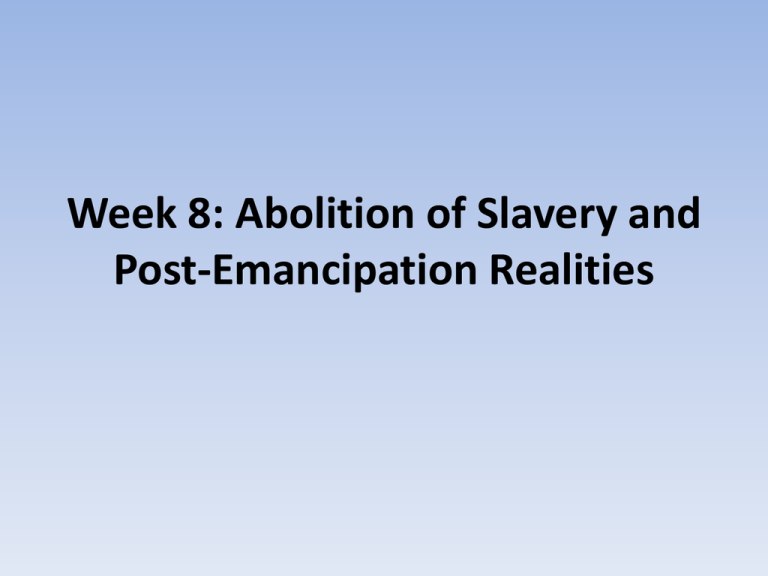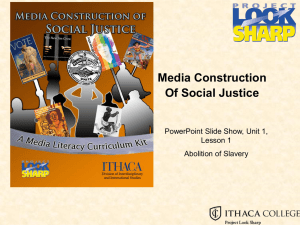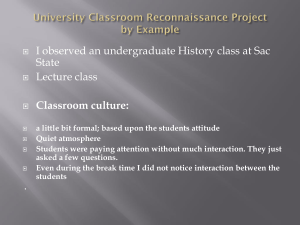Week 8: Abolition of Slavery and Post-Emancipation Realities
advertisement

Week 8: Abolition of Slavery and Post-Emancipation Realities Last week • “Regresso”: “return” to “order” and centralised rule: Second Empire • Monarchy; patronage; peaceful powersharing by two main parties (Liberals/ Conservatives) • How “democratic”? • Beginning of breakdown of the old order in the 1860s..? Effects of Paraguayan War (maybe?)… • • • • • • Major casualties, exhaustion/ frustration Brazil back in debt to Britain Slavery shown to be unviable (?) Emperor loses credibility (?) Provokes political crisis in Brazil (?) Split of Liberals to form Republican Party, 1871 Intersecting factors in late C19 Brazil • War in Paraguay • Gradual emancipation, and eventual abolition of slavery • Breakdown of old political consensus • New ideas about both race and politics (positivism; republicanism) • Demographic/ social changes (urbanisation; immigration) • Downfall of monarchy Context: Brazilian slave society up to 1850 • Most deeply-rooted slave society in Americas • Sugar (C17) then mining (C18); then coffee (C19) • But also slaves employed in wide variety of urban and other occupations • At same time, high numbers of FREE PEOPLE OF COLOUR • Racial mixing; manumission (does not mean not “racist” society; but different from e.g. US) • Slaveholding is fairly accessible; many Brazilians own e.g. 1-2 slaves (including former slaves and free people of colour) • Close economic & cultural connections to Africa “A free negress and other market women” (Brazil 1821) James Henderson, A History of the Brazil. . . (London, 1821), facing p. 71. Slave society after 1850 • Closing of Atlantic trade in 1850 • Slave prices rise; slaveholding becomes more concentrated (although still widespread) • Gradual decline of North-East; slaves sold SOUTH in major internal trade • Provinces end up with different degrees of investment in institution of slavery Arguments for the abolition of slavery • Abolitionist arguments since start of C19 • Contradiction between liberalism and slavery • Economic rationalist / modernity arguments (slavery backward/ unproductive/ not “modern”/ need for free labour/ immigration); racist elements (whitening) • Humanist arguments: cruelty of slavery; fundamental human equality; some religious rhetoric The path toward abolition • 1871 “Free Womb Law” (Rio Branco Law) frees children born to enslaved women • 1885 Saraiva-Cotegipe Law frees the elderly, facilitates self-purchase by slaves • 1886 abolition of the whip • 1887 mass flights by slaves from fazendas in Sao Paulo and other areas; army refuses to pursue them • 13 May 1888 “Golden Law” abolishes slavery Who abolished slavery? • Abolitionists? - Elite political figures e.g. Joaquim Nabuco? • Abolitionists? Non-white radical public figures e.g. Jose do Patrocinio, Andre Reboucas, Luiz Gama? • Broader popular abolition movement, including non-elite sectors, urban dwellers, women? • Imperial Family? • The enslaved themselves? (mass flight; rebellion; manumission through own struggles) Zumbi, last leader of quilombo of Palmares Consequences of abolition • Despite celebrations, no SOCIAL REFORM – former slaves denied access to land or education; elite political dominance continues, franchise much SMALLER after 1881 Reform Act • Decline of older coffee regions (Rio de Janeiro), some regional elites feel betrayed, elsewhere coffee economy thrives (S Paulo) • Paves way for mass immigration schemes: Italians, Portuguese, Spaniards...



